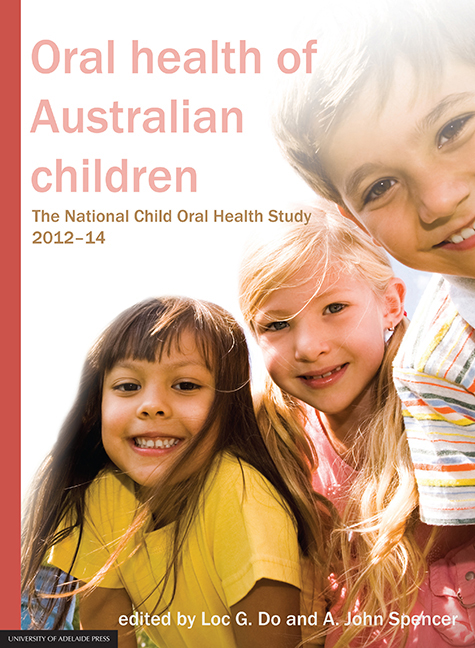Book contents
- Frontmatter
- List of Contributors
- Contents
- Preface
- Executive Summary
- 1 Children's oral health – assessing and improving oral health
- 2 Measuring child oral health and its influences
- 3 Data weighting, consideration and estimation procedures
- 4 Measuring representativeness of the study participants
- 5 Children's oral health status in Australia, 2012–14
- 6 Patterns of dental services use by Australian children
- 7 Australian children's oral health behaviours
- 8 Australian children's general health behaviours
- 9 Social gradients in child oral health
- 10 Oral health status and behaviours of Indigenous Australian children
- 11 Trends in child oral health in Australia
- 12 Interpretation of findings and a way forward to improving oral health and dental care
- 13 Appendix
- State and territory survey personnel
- Symbols
- Abbreviations
- Place names
- Glossary
- List of tables
- List of figures
3 - Data weighting, consideration and estimation procedures
Published online by Cambridge University Press: 05 September 2017
- Frontmatter
- List of Contributors
- Contents
- Preface
- Executive Summary
- 1 Children's oral health – assessing and improving oral health
- 2 Measuring child oral health and its influences
- 3 Data weighting, consideration and estimation procedures
- 4 Measuring representativeness of the study participants
- 5 Children's oral health status in Australia, 2012–14
- 6 Patterns of dental services use by Australian children
- 7 Australian children's oral health behaviours
- 8 Australian children's general health behaviours
- 9 Social gradients in child oral health
- 10 Oral health status and behaviours of Indigenous Australian children
- 11 Trends in child oral health in Australia
- 12 Interpretation of findings and a way forward to improving oral health and dental care
- 13 Appendix
- State and territory survey personnel
- Symbols
- Abbreviations
- Place names
- Glossary
- List of tables
- List of figures
Summary
Sample surveys are conducted to make informed inferences about a target population. In order to produce reliable estimates of population parameters a sample should reflect the characteristics of the target population from which it is drawn. This rarely happens in practice as sample designs commonly select participants with unequal probabilities of selection leading to certain groups within the target population being over- or under-represented in the sample. Similarly, survey response rates often vary significantly by sociodemographic status leading to samples that are unrepresentative of the target population and therefore biased population estimates. These concerns can be addressed by the application of survey weights that adjust the sociodemographic composition of the sample to reflect the target population. Consequently, population estimates derived from the weighted sample more closely reflect the true population parameters.
The National Child Oral Health Study (NCOHS) sampled 24,664 children from primary and secondary schools across Australia to estimate the oral health status of children aged 5–14 years. To produce reliable state and territory survey estimates, children from less populated jurisdictions were oversampled and therefore had a higher chance of selection in the Survey. Similarly, children from fluoridated areas of Queensland were oversampled to ensure a sufficient sample size to produce reliable survey estimates by fluoride exposure in that state. As the oral health status of Australian children varies significantly by geographic region (Centre for Oral Health Strategy 2009; Centre for Oral Health Strategy 2013; Do & Spencer 2014; Mejia et al. 2012), it was paramount that the weighting strategy accounted for these differential probabilities of selection.
Furthermore, analysis of the NCOHS sample highlighted differences in response rates by type of school attended and across a range of child, parent and household sociodemographic characteristics. Children from parents with a high level of education were over-represented in the sample. Conversely, Indigenous children and children from single parent families were under-represented. Response rates also varied by geographic region with participation lower in capital cities than other regions. As the association between sociodemographic status and children's oral health is well established (Centre for Oral Health Strategy 2009; Centre for Oral Health Strategy 2013; Do & Spencer 2014; Mejia et al. 2012; Armfield et al. 2006), the weighting strategy was designed to correct for the differential response rates inherent in the Survey.
- Type
- Chapter
- Information
- Oral Health of Australian ChildrenThe National Child Oral Health Study 2012-14, pp. 35 - 47Publisher: The University of Adelaide PressPrint publication year: 2016



